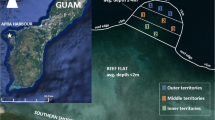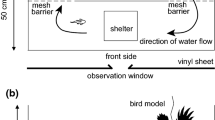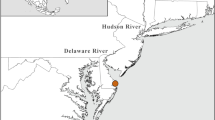Abstract
In many salmon and charr, both 'migratory males' and 'precocious males' are maintained as alternative life-histories within a population. During breeding, precocious males gather around the mating pair of migratory fish and attempt to sneak in the spawning between larger male and female charr. Refuges such as debris and shallow areas may provide shelter from aggressive attacks and allow precocious males to hold positions closer to the pair (nest) and/or sneak more easily during the mating. Here we examine whether the availability of refuges influences the breeding behavior of precocious male parr of the Miyabe charr under experimental and natural conditions. Aggressive attacks directed toward precocious parr by the mating pair or other parr was not influenced by the refuge availability either under experimental conditions or in the wild. We did not find the effect of high refuge availability on the proximity of parr to the nest beyond the experimental conditions where the density of refuges was probably higher than in the natural stream. There were no effects of high refuge availability either on parr's attempts at sneak mating or on their success in spawning. Thus, our results provide little evidence that the refuge availability influences parr sneaking behavior. Other possible effects of high refuge availability, for example, the increase of fertilization success and the decrease of energy expenditure and risk taking, remain to be considered.
Similar content being viewed by others
References cited
Berglund, A. 1993. Risky sex: male pipefishes mate at random in the presence of a predator. Anim. Behav. 46: 169–175.
Candolin, U. 1997. Predation risk affects courtship and attractiveness of competing threespine stickleback males. Behav. Ecol. Sociobiol. 41: 81–87.
Candolin, U. & H.-R. Voigt. 1998. Predator-induced nest site preference: safe nests allowcourtship in sticklebacks. Anim. Behav. 56: 1205–1211.
de Fraipont, M., G.J. Fitzgerald & H. Guderley. 1993. Age-related differences in reproductive tactics in the three-spined stickleback, Gasterosteus aculeatus. Anim. Behav. 46: 961–968.
Fleming, I.A. & M.R. Gross. 1994. Breeding competition in a Pacific salmon (coho: Oncorhynchus kisutch): measures of natural and sexual selection. Evolution 48: 637–657.
Foote, C.J., G.S. Brown & C.C. Wood. 1997. Spawning success of males using alternative mating tactics in sockeye salmon, Oncorhynchus nerka. Can. J. Fish. Aquat. Sci. 54: 1785–1795.
Godin, J.-G.J. 1995. Predation risk and alternative mating tactics in male Trinidadian guppies (Poecilia reticulata). Oecologia 103: 224–229.
Gross, M.R. 1984. Sunfish, salmon, and the evolution of alternative reproductive strategies and tactics in fish. pp. 55–75. In: R.J. Wootton & G. Potts (ed.) Fish Reproduction: Strategies and Tactics, Academic Press, London.
Gross, M.R. 1985. Disruptive selection for alternative life histories in salmon. Nature 313: 47–48.
Gross, M.R. 1991. Salmon breeding behavior and life history evolution in changing environments. Ecology 72: 1180–1186.
Gross, M.R. 1996. Alternative reproductive strategies and tactics: diversity within sexes. Trends Ecol. Evol. 11: 92–98.
Hanson, A.J. & H.D. Smith. 1967. Mate selection in a population of sockeye salmon (Oncorhynchus nerka) of mixed age group. J. Fish. Res. Board Can. 24: 1955–1977.
Hino, T., K. Maekawa & J.B. Reynolds. 1990. Alternative male mating behaviors in landlocked Dolly Varden (Salvelinus malma) in south-central Alaska. J. Ethol. 8: 13–20.
Hutchings, J.A. & R.A. Myers. 1985. Mating between anadromous and nonanadromous Atlantic salmon, Salmo salar. Can. J. Zool. 63: 2219–2221.
Hutchings, J.A. & R.A. Myers. 1987. Escalation of an asymmetric contest: mortality resulting from mate competition in Atlantic salmon, Salmo salar. Can. J. Zool. 65: 766–768.
Hutchings, J.A. & R.A. Myers. 1988. Mating success of alternative maturation phenotypes in male Atlantic salmon, Salmo salar. Oecologia 75: 169–174.
Hutchings, J.A. & R.A. Myers. 1994. The evolution of alternative mating strategies in variable environments. Evol. Ecol. 8: 256–268.
Jones, J.W. 1959. The salmon. Collins, London. 192 pp.
Jonsson, N., B. Jonsson & L.P. Hansen. 1991. Energetic cost of spawning in male and female Atlantic salmon (Salmo salar L.). J. Fish Biol. 39: 739–744.
Jonsson, N., B. Jonsson & L.P. Hansen. 1997. Changes in proximate composition and estimates of energetic costs during upstream migration and spawning in Atlantic salmon Salmo salar. J. Anim. Ecol. 66: 425–436.
Koseki, Y. & K. Maekawa. 2000. Sexual selection on mature male parr of masu salmon (Oncorhynchus masou): does sneaking behavior favor small body size and less-developed sexual characters? Behav. Ecol. Sociobiol. 48: 211–217.
Maekawa, K. 1978. Growth and development of Salvelinus malma miyabei compared with other forms of S. malma. Japan. J. Ichthyol. 25: 9–18.
Maekawa, K. 1983. Streaking behaviour of mature male parrs of the Miyabe charr, Salvelinus malma miyabei, during spawning. Japan. J. Ichthyol. 30: 227–234.
Maekawa, K. 1984. Life history pattern of the Miyabe charr in Shikaribetsu Lake, Japan. pp. 223–250. In: L. Johnson & B. Burns (ed.) Biology of the Arctic Charr, University of Manitoba Press, Winnipeg.
Maekawa, K. & H. Onozato. 1986. Reproductive tactics and fertilization success of mature male Miyabe charr, Salvelinus malma miyabei. Env. Biol. Fish. 15: 119–129.
Maekawa, K. & T. Hino 1990. Spawning tactics of female Miyabe charr (Salvelinus malma miyabei) against egg cannibalism. Can. J. Zool. 68: 889–894.
Maekawa, K., S. Nakano & S. Yamamoto. 1994. Spawning behaviour and size-assortative mating of Japanese charr in an artificial lake-inlet stream system. Env. Biol. Fish. 39: 109–117.
Magnhagen, C. 1991. Predation risk as a cost of reproduction. Trends Ecol. Evol. 6: 183–186.
Magnhagen, C. 1992. Alternative reproductive behaviour in the common goby, Pomatoschistus microps: an ontogenetic gradient? Anim. Behav. 44: 182–184.
Magnhagen, C. 1995. Sneaking behaviour and nest defence are affected by predation risk in the common goby. Anim. Behav. 50: 1123–1128.
Magurran, A.E. & M.A. Nowak. 1991. Another battle of the sexes: the consequences of sexual asymmetry in mating costs and predation risk in the guppy, Poecilia reticulata. Proc. R. Soc. Lond. B 246: 31–38.
Mjølnerød, I.B., I.A. Fleming, U.H. Refseth & K. Hindar. 1998. Mate and sperm competition during multiple-male spawnings of Atlantic salmon. Can. J. Zool. 76: 70–75.
Morán, P., A.M. Pendás, E. Beall & E. García-Vázquez. 1996. Genetic assessment of the reproductive success of Atlantic salmon precocious parr by means of VNTR loci. Heredity 77: 655–660.
Myers, R.A. & J.A. Hutchings. 1987. Mating of anadromous Atlantic salmon, Salmo salar L., with mature male parr. J. Fish Biol. 31: 143–146.
Quinn, T.P. & C.J. Foote. 1994. The effects of body size and sexual dimorphism on the reproductive behaviour of sockeye salmon, Oncorhynchus nerka. Anim. Behav. 48: 751–761.
Sih, A. 1994. Predation risk and the evolutionary ecology of reproductive behaviour. J. Fish Biol. 45 (Suppl. A): 111–130.
Sundbaum, K. & I. Näslund. 1998. Effects of woody debris on the growth and behaviour in brown trout in experimental stream channels. Can. J. Zool. 76: 56–61.
Taborsky, M. 1994. Sneakers, satellites, and helpers: parasitic and cooperative behavior in fish reproduction. Adv. Study Behav. 23: 1–100.
Tamate, T. & K. Maekawa. 2000. Life cycle of masu salmon (Oncorhynchus masou) in Shumarinai Lake, northern Hokkaido, Japan. Eurasian J. For. Res. 1: 39–42.
Thomaz, D., E. Beall & T. Burke. 1997. Alternative reproductive tactics in Atlantic salmon: factors affecting mature parr success. Proc. R. Soc. Lond. B 264: 219–226.
Author information
Authors and Affiliations
Rights and permissions
About this article
Cite this article
Koseki, Y., Koizumi, I., Kobayashi, H. et al. Does the Refuge Availability Influence the Spawning Behavior of Mature Male Parr in Salmonids? A Test in the Miyabe Charr. Environmental Biology of Fishes 64, 87–93 (2002). https://doi.org/10.1023/A:1016096701472
Issue Date:
DOI: https://doi.org/10.1023/A:1016096701472




